|
|
 |
| Oncaeidae Giesbrecht, 1893 ["1892"] ( Cyclopoida ) * | | Syn.: | Oncäidae part.Giesbrecht,1892 (p.81); Oncaeidae part.: Esterly, 1905 (p.215); van Breemen, 1908 a (p.184); Sars, 1918 (p.190); Rose, 1933 a (p.295); Mori, 1937 (1964) (p.119); Humes & Stock, 1973 (p.6); Heron, 1977 (p.38, Genera key); Boxshall, 1977 a (p.109, Def., Rem.); Heron & Damkaer, 1978 (p.3, Genera key); Björnberg & al., 1981 (p.665); Razouls, 1982 (p.665); Bowman & Abele, 1982 (p.12); Heron & al., 1984 (p.449); Zheng Zhong & al., 1984 (1989) (p.262, Genera key); Sazhina, 1985 (p.93); Boxshall & Huys, 1988/89 (p.164, 172); Huys & Boxshall, 1991 (p.465); Razouls,1993 (p.313); Heron & Bradford-Grieve, 1995 (p.11, 45, Rev., Genera key); Chihara & Murano, 1997 (p.978, Pl.220); Bradford-Grieve & al., 1999 (p.887, 969, Genera Key) | | Ref.: | Huys & Böttger-Schnack, 1996/97 (p.243, 246, Redef.); Heron & Frost, 2000 (p.1016, Genera Key); Boxshall & Halsey, 2004 (p.17; 613: Def.; p.615: Genera key. Rem. p.1: For the authors the order Poecilostomatoida is questionable); Di Capua & Boxshall, 2008 (p.1413: Key to species females in the Gulf of Naples); Vives & Shmeleva, 2010 (p.258, Rem., Genera key from Iberica Fauna); Böttger-Schnack & Machida, 1011 (p.111, DNA sequences, phylogeny); Böttger-Schnack & Schnack, 2013 (p.265, species groups: Def.); Böttger-Schnack & Schnack, 2015 (p.1, Table 1, 3, 5, morphological characters for identification); Hirai & al., 2020 (p.1, Fig.4: metabarcoding, Fig.8: OTUs distribution patterns, Fig.9: phylogenetic analysis) | | Rem.: | Boxshall & Halsey (2004, p. 615) admettent le genre Triconia, malgré les arguments données par Heron & Frost (2000). Le genre Pachos doit être retiré de cette famille (incertae sedis). 7 G.: Archioncaea, Conaea, Epicalymma, Monothula, Oncaea, Spinoncaea, Triconia.
D'après Böttger-Schnack (comm. pers., 2009), l'année de publication de la monographie de Giesbrecht sur les copépodes pélagiques de la Baie de Naples devrait être citée comme Giesbrecht 1893 ["1892"] (pour explication, voir la note de Ruth Böttger-Schnack pour la famille des Oncaeidae dans le site du WoRMS). | | * Nous remercions Ruth Böttger-Schnack (Universität Bremen) de nous avoir adressé copie des familles Corycaeidae, Oncaeidae et Sapphirinidae de la faune du Japon de Chihara et Murano (1997), ainsi que la traduction anglaise concernant la famille des Oncaeidae effectuée par Hiroshi Itoh. |  Issued from : Boxshall & Halsey in The Ray Society, 2004, Part II. [p.613]. Armature formula of swimming legs P1 to P4. Nota: Inner seta on basis of P1 present or absent. Setation often modified by loss of elements from both rami. Endopod of P4 armature 0-1; 0-2; I, II, 2 or with terminal armature reduced to 0, II, I, or 0, II, 1, or 0, I, 1. P2 and P3 usually with conical process between distal spines on endopod; process present on P4 in Triconia. - P5 laterally located on somite; protopod incorporated into somite, usually represented by seta on surface of somite but absent in Archioncaea; exopod 1-segmented typically armed with 2 setae0, or reduced to single seta plus a spinule, on surface, or absent; exopod bearing 3 setae in Archioncaea. - P6 represented by genital opercula; armed with 1 seta in female, unarmed in male. - Egg sacs typically paired, multiseriate, single egg sac carried in Monothula. Remarks: See separation of genera and species groups showing leg armature type 1 (Table 4) in Böttger-Schnack & Schnack (2013, p.4). |
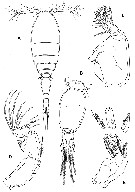 Issued from : Boxshall & Halsey in The Ray Society, 2004, Part II. [p.614, Fig.199). A, Triconia borealis (as Oncaea borealis) female; B, Oncaea media f minor male urosome; C, Oncaea venusta Mx2; D, A2; E, Md.
After Sars, 1918: A; Huys & Boxshall, 1991: B-E. |
 Issued from : R. Böttger-Schnack & D. Schnack in J. Nat. Hist., 2015. [p.5, Table 1].. |
 Issued from : R. Böttger-Schnack & D. Schnack in J. Nat. Hist., 2015. [p.10, Table 2]. In several cases some additional, secondary characters are required for a final identification of species. For example, the length to width ratio of the caudal ramus can be used to separate species within the genus Oncaea s. str. or the length of the outer basal seta on P5 can separate the five described species belonging to the dentipes-subgroup of Triconia. |
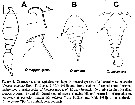 Issued from : R. Böttger-Schnack & D. Schnack in J. Nat. Hist., 2015. [p.7, Fig.4]. |
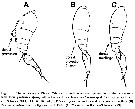 Issued from : R. Böttger-Schnack & D. Schnack in J. Nat. Hist., 2015. [p.7, Table 5]. |
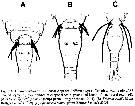 Issued from : R. Böttger-Schnack & D. Schnack in J. Nat. Hist., 2015. [p.8, Fig.6]. Nota: Reed in (A) Oncaea serrulata and no serrata. |
 Issued from : R. Böttger-Schnack & D. Schnack in J. Nat. Hist., 2015. [p.8, Fig.7]. |
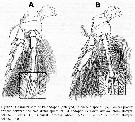 Issued from : R. Böttger-Schnack & D. Schnack in J. Nat. Hist., 2015. [p.9, Fig.8]. |
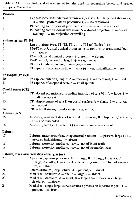 Issued from : R. Böttger-Schnack & D. Schnack in J. Nat. Hist., 2013, (4-7). [p.9, Table 2]. Main morphological characters of females used for separating genera and species groups of Oncaeidae |
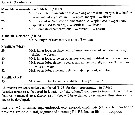 Issued from : R. Böttger-Schnack & D. Schnack in J. Nat. Hist., 2013, (4-7). [p.10, Table 2 (Continued)]. Main morphological characters of females used for separating genera and species groups of Oncaeidae |
 Issued from : R. Böttger-Schnack & D. Schnack in J. Nat. Hist., 2013, (4-7). [p.11, Table 3]. Morphological characters of oncaeid genera and of species groups within Oncaea s.l. Nota: Differences in labral structure have been found to be very important, separating e.g. the compacta-group, the olsoni-group, and the ovalis-group from closely related groups or genera. The distinct formation of a distal conical process on endopodite 3 of P4 is typically found in the genus Triconia (but see the discussion of O. insolita Heron & Frost). The number of elements on the endopodite 2 of A2 and/or their ornamentation separate the tregoubovi-group from the prendeli-group and are unique in the tenuimana-group. A very elogate P5 exopod segment is typically found only in the notopus-group. The only other group sharing this character, the longipes-group differs in leg armature. In summary, based on the characters shown in Table 3, group separation is uniquivocal for all taxa sharing leg armature type 1, even for some very closely related genera and groups, except for the monotypic curvarta-group, which is rather similar to the tregoubovi-group and the olsoni-group in the Table. However, separation is obvious when considering the proportional lengths of the urosomites in addition, showing relatively short genital double-somite and very long postgenital somites in O. curvata compared with the tregoubovi-group and the olsoni-group. Additional information is also required for grouping the new morphospecies Oncae sp. A-MedSea, for which the complete set of morphological characters has not yet been examined. The species appears to be unique by the nature and position of the genital apertures of the female, located extremely laterally on the genital double-somite. At present only one species of Triconia ( T. gonopleura) has been found to show a similar character, but the absence of a conical process on the distal endopod segment of P4 in sp. A-MedSea clearly points that the two species belong to different groups. The speciose genus Triconiaconifera- vs. similis-subgroup). However, a further subgrouping may be necessary, as it has been found by Böttger-Schnack & Machida (2011) that a minuta-subgroup can be split from the similis-subgroup by the proportional spine lengths on endopodite 3 of P2, and by genetic evidence. |
 Issued from : R. Böttger-Schnack & D. Schnack in J. Nat. Hist., 2013, (4-7). [p.12, Table 3 (Continued)]. Morphological characters of oncaeid genera and of species groups within Oncaea s.l. |
 Issued from : R. Böttger-Schnack & D. Schnack in J. Nat. Hist., 2013, (4-7). [p.13, Table 3 (Continued)]. Morphological characters of oncaeid genera and of species groups within Oncaea s.l. |
 Issued from : R. Böttger-Schnack & D. Schnack in J. Nat. Hist., 2013, (4-7). [p.14, Table 4]. Leg armature of Oncaeidar typical leg armature (Type 1) found in the majority of species*. Nota: Two oncaeid genera, Oncaea s.str., and Triconia, eight species groups of Oncaea s.l. and one new morphospecies of uncertain taxonomic status ( Oncaea sp.A-MedSea) share leg armature type 1 (Table 3), i.e. the typical spine and setal count on the swimming legs (cf. Table 4). In total 73 species, corresponding to 2/3 of all described oncaeids and one of the new morphospecies, share this ''typical'' leg armature. For an unequivocal classification of these specues groups and genera, other morphological characters have to be considered in addition, most of which are presented in Table 3. Deviations from this typical leg armature are provided in Table 5 and 6, listing only those parts of the legs, where modified spine counts can be found. |
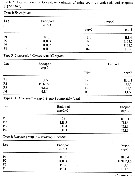 Issued from : R. Böttger-Schnack & D. Schnack in J. Nat. Hist., 2013, (4-7). [p.15, Table 5]. Leg armature of Oncaeidae variation of spine count on endopods and exopods (Type 2 to 8). |
 Issued from : R. Böttger-Schnack & D. Schnack in J. Nat. Hist., 2013, (4-7). [p.16, Table 5 (Continued)]. Leg armature of Oncaeidae variation of spine count on endopods and exopods (Type 2 to 8). |
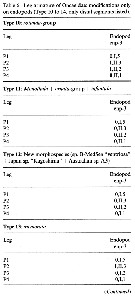 Issued from : R. Böttger-Schnack & D. Schnack in J. Nat. Hist., 2013, (4-7). [p.17, Table 6]. Leg armature of Oncaeidae modifications only on endopods (Type 10 to 14), only distal segments listed). |
 Issued from : R. Böttger-Schnack & D. Schnack in J. Nat. Hist., 2013, (4-7). [p.18, Table 6 (Continued)]. Leg armature of Oncaeidae modifications only on endopods (Type 10 to 14), only distal segments listed). |
 Issued from : R. Böttger-Schnack & D. Schnack in J. Nat. Hist., 2013, (4-7). [p.8, Table 1 C]. |
 Issued from : R. Böttger-Schnack & D. Schnack in J. Nat. Hist., 2013, (4-7). [p.7, Table 1 B]. |
 Issued from : R. Böttger-Schnack & D. Schnack in J. Nat. Hist., 2013, (4-7). [p.8, Table 1 B]. | | | | | (1) Archioncaea Böttger-Schnack & Huys, 1997 | |
| | Ref.: | Böttger-Schnack & Huys, 1997 (p.80); Boxshall & Halsey, 2004 (p.613, 615); Böttger-Schnack & Schnack, 2013 Table 1, 5, (p.18, Rem. | | Rem.: | Total: 1 sp.: |  Issued from : R. Böttger-Schnack & D. Schnack in J. Nat. Hist., 2013, (4-7). [p.4, Table 1, A]. Species list of Oncaeidae in the world ocean according to Boxshall & Halsey (2004) complementrd by Böttger-Schnack (2001). | | | | | (2) Conaea Giesbrecht, 1891 | |
| | Syn.: | Conäa Giesbrecht, 1891; 1892 (p.82, 605) | | Ref.: | A. Scott, 1909 (p.243); van Breemen, 1908 a (p.191); Rose, 1933 a (p.303); Davis, 1949 (p.77); Heron, 1977 (p.38, 86, spp. Key); Boxshall, 1977 a (p.145); Razouls, 1982 (p.678); Malt, 1982 (p.191, 192, Rem.); Heron & al., 1984 (p.449); Razouls, 1993 (p.313); Heron & Bradford-Grieve, 1995 (p.45, Déf., Rem.); Huys & Böttger-Schnack, 1996/97 (p.245, 246, Rem.); Böttger-Schnack & Huys, 1998 (p.369); Bradford-Grieve & al., 1999 (p.970, spp. key); Heron & Frost, 2000 (p.1060, spp. key); Boxshall & Halsey, 2004 (p.613, 615); Vives & Shmeleva, 2010 (p.260, Rem.); Böttger-Schnack & Schnack, 2013 (p.19, Rem.) | | Rem.: | type: Conäa rapax Giesbrecht,1891. 4 spp. | | Remarques sur les dimensions et le sex-ratio: | | The size ratio (male : female) is 0.886 (n = 3; SD = 0.0111) or 89 %, if we consider the ratio for each species. |  Issued from : R. Böttger-Schnack & D. Schnack in J. Nat. Hist., 2013, (4-7). [p.4, Table 1, A]. Species list of Oncaeidae in the world ocean according to Boxshall & Halsey (2004) complementrd by Böttger-Schnack (2001). Total body length (mm): The mean female size is 0.770 mm (n = 7; SD = 0.2083) and the mean male size is 0.7375 (n = 4; SD = 0.2127). The size ratio (male : female) is 0.958.The sex ratio (female : male) is 1.333 | | | | | (3) Epicalymma Heron, 1977 | |
| | Syn.: | Oncaea : Malt, 1982 (part., p.192) | | Ref.: | Heron, 1977 (p.82); Razouls, 1982 (p.682); Heron & al., 1984 (p.449, 479, spp. key); Razouls, 1993 (p.313); Heron & Bradford-Grieve, 1995 (p.45, Rem.); Huys & Böttger-Schnack, 1996/97 (p.245, 246, Rem.); Heron & Frost, 2000 (p.1058, spp. key); Boxshall & Halsey, 2004 (p.613, 615); Vives & Shmeleva, 2010 (p.262, Rem., spp. key); Böttger-Schnack & Schnack, 2013 (Table 1, 3, 5, p.19, Rem.) | | Rem.: | Malt (1982, p.185) considère ce genre comme synonyme de Oncaea contrairement à Heron & al. (1984) et Heron & Bradford-Grieve (1995). Type: Epicalymma schmitti. 7 spp.: | | Remarques sur les dimensions et le sex-ratio: | | Si l'on calcule les rapports espèce par espèce, la moyenne des longueurs des femelles est de 0,559 mm (n= 6; S= 0,105; Cv= 0,188) et de 0,483 mm pour les mâles (n= 3; S= 0,097; Cv= 0,201). Le rapport des longueurs (M/F) est de 0,948 ou 94,8 % (n= 3; S= 0,161; Cv= 0,17). |  Issued from : R. Böttger-Schnack & D. Schnack in J. Nat. Hist., 2013, (4-7). [p.4, Table 1, A]. Species list of Oncaeidae in the world ocean according to Boxshall & Halsey (2004) complementrd by Böttger-Schnack (2001). Total body length (mm): the mean female size is 0.5292 (n = 13; SD = 0.1663), and the mean male size is 0.4796 (n = 10; SD = 0.1546). The size ratio (male : female) is 0.906. The sex ratio (female : male) is 1.666. | | | | | (4) Monothula Böttger-Schnack & Huys, 2001 | |
| | Ref.: | Böttger-Schnack & Huys, 2001 (p.468); Boxshall & Halsey, 2004 (p.613, 615); Vives & Shmeleva, 2010 (p.266, Rem..); Böttger-Schnack & Schnack, 2013 (Table 1, 3, 6, p.19, Rem.) | | Rem.: | type: Oncaea subtilis Giesbrecht,1892. Total: 1 sp. |  Issued from : R. Böttger-Schnack & D. Schnack in J. Nat. Hist., 2013, (4-7). [p.4, Table 1, A]. Species list of Oncaeidae in the world ocean according to Boxshall & Halsey (2004) complementrd by Böttger-Schnack (2001). | | | | | Myspictosum Kazatchenko & Andreev, 1977 | | Ref.: | Razouls, 1982 (p.683); Malt, 1982 (p.192, Rem.) | | Rem.: | Cf. Oncaea | | | | (5) Oncaea Philippi, 1843 | |
| | Syn.: | Antaria Dana, 1846; Conäa Giesbrecht, 1891; Oncäa : Giesbrecht, 1892 (p.81, 590); Myspictosum Kazatchenko & Andreev, 1977 (p.47) | | Ref.: | Sars, 1900 (part., p.106); Wheeler, 1901 (p.190); Esterly, 1905 (p.215); van Breemen, 1908 a (p.184); Farran, 1908 b (p.95, spp. key of Females); A. Scott, 1909 (p.241); Sars, 1918 (p.190); Pesta, 1920 (p.650 spp. key); Wilson, 1932 a (p.350, spp. key); Rose, 1933 a (p.295, spp. nkey of Females); Mori, 1937 (1964) (p.119); Dakin & Colefax, 1940 (p.116, spp. key); Davis, 1949 (p.76); Shmeleva, 1968 (p.1791, clé spp.); 1969 (p.3, 25, spp. key); Ferrari, 1975 (p.217, 230, clé spp.); Heron, 1977 (p.40, spp. key); Razouls, 1982 (p.665); Gardner & Szabo, 1982 (p.113); Malt, 1982 (p.192, Rev.); 1982 a (p.140, key. N, juv.); 1983 a (p.4, spp. key); 1983 b (p.449, polymorphism); Heron & al., 1984 (p.461, clé spp., Rem.); Zheng Zhong & al., 1984 (1989) (p.262, spp. key); Böttger-Schnack & al., 1989 (p.1089, Rem.: biology); Huys & Boxshall, 1991 (p.465); Heron & Bradford-Grieve, 1995 (p.13, Déf., spp. key of Females, Rem.); Chihara & Murano, 1997 (p.979, Pl.221); Böttger-Schnack & Huys, 1998 (p.369, Rem.: phylogeny); Bradford-Grieve & al., 1999 (p.970, spp. key); Heron & Frost, 2000 (p.1017, spp. key, Rem.: For the authors the genus Triconia is questionable); Böttger-Schnack, 2001 (p.28, Déf.); Boxshall & Halsey, 2004 (p.613, 615); Vives & Shmeleva, 2010 (p.269, Rem., spp. key from Iberica Fauna); Böttger-Schnack & Machida, 1011 (p.111, DNA sequences, phylogeny); Böttger-Schnack, 2013 (Table 1: sub)groups, Table 3, 5, 6: subgroups identifications, p.18: Rem.) . | | Rem.: | Malt (1982, p.191, 192) considère les 2 genres Conaea et Epicalymma comme des synonymes de Oncaea alors que Heron & al. (1984) et Heron & Bradford-Grieve (1995) estiment qu'ils doivent être maintenus. Type: Oncaea venusta Philippi,1843. Total: 71 spp. + 1 indét.: |  issued from : C.T. Achuthankutty, N. Ramaiah & G. Padmavati in Pelagic biogeograpgy ICoPB II. Proc. 2nd Intern. Conf. Final report of SCOR/IOC working group 93, 9-14 July 1995. Workshop Report No. 142, Unesco, 1998. [p.8, Fig.6]. Salinity ranges for Oncaea spp. in coastal and estuarine waters of Goa (India). Shaded area indicates the range of higher abundance. |
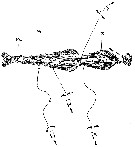 issued from : Y.-B. Go, B.-C. Oh & M. Terazaki in J. Mar. Syst., 1998, 15. [p.480, Fig.4]. Attacking behaviors of Oncaea spp. on the body of Sagitta (Chaetognatha). FVL: head trunk in front fins; VG: ventral ganglion; CS: caudal septum Nota: Direct underwater observations with SCUBA were performed at night (Ceju Island, off South Korea) The attack behavior of Oncaea started mostly below the stationary Sagitta in the field (surface water). The attack distance at which Oncaea spp. approached Sagitta from below was about 5-6 cm; the attacking behavior from the upper side of Sagitta was observed only occasionally, and the attack distance was about 1-3 cm. This behaviour suggests that Oncaea is not a touch feeder. The attachment sites of Oncaea on the body of Sagitta spp. were for a total of 320 individuals: ventral side 56.3 %, lateral side 32.8 % and dorsal side 10.9 %. Oncaea crept directly to the chaetognath tail or the head region using their second antennae, and pierced the body of chaetognaths with the long claw of the maxilliped, and moved maxillae and mandibles. The chaetognaths did not move at all when this copepod was crawling on the body. Early copepodid stages and adult females with egg sacs were found attached to Sagitta spp. |
 issued from : Y.-B. Go, B.-C. Oh & M. Terazaki in J. Mar. Syst., 1998, 15. [p.479, Table 1]. Frequency of the various zooplankton to which Oncaea spp. attached in the coastal upwelling area (Cheju Island, off South Korea). n: number of observations; q: less than 0.05 %. |
 issued from : Y.-B. Go, B.-C. Oh & M. Terazaki in J. Mar. Syst., 1998, 15. [p.481, Table 4]. Occurrence frequency (%) of food items in the guts of Oncaea spp. collected in coastal waters of Cheju Island (off South Korea). A total of 50 individuals were examined.
Nota: Midgut contents of Oncaea spp. sampled during both day and night were examined by SEM.
The greater part of the midgut of these copepods collected at both periods was empty, and the contents consisted mainly of unidentified fine particles, and occasionally larvaceans houses, diatoms fragments, coccoliths, dinoflagellates, crustacean fragments. |
 Issued from : Böttger-Schnack & Schnack in J. Nat. Hist., 2013, 47. [p.4, Table 1, A]. Species list of Oncaea s.str. in the world ocean from Boxshall & Halsey (2014) complemented by Böttger-Schnack (2001). Total length (mm): The mean female size is 0.7975 mm (n = 16; SD = 0.3685) and the mean male size is 0.6793 mm (n = 14; SD = 0.4359). The size ratio (male : female) is 0.852 or ± 85 %. The sex ratio (female : male ) is 1.14. The mean size ratio (male : female) is 0.849 (n = 7; SD = 0.3164) or 85%, if we consider the ratio for each species. |
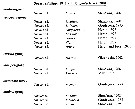 Issued from : Böttger-Schnack & Schnack in J. Nat. Hist., 2013, 47. [p.5, Table 1, A]. Species list of Oncaea s.l. in the world ocean from Boxshall & Halsey (2014) complemented by Böttger-Schnack (2001). Total length (mm) in compacta-group: The mean female size is 0.6643 mm (n = 14; SD = 0.1207), and the mean male size is 0.5966 mm (n = 6; SD = 0.1127). The size ratio (male : female) is 0.898 or ± 90 %. The sex ratio (female : male ) is 1.75. The mean size ratio (male : female) is 0.859 (n = 4; SD = 0.0488) or 86%, if we consider the ratio for each species with male and female together. Total length (mm) in longipes-group: The mean female size is 0.295 mm (n = 4; SD = 0.050), and the mean male size is 0.245 mm (n = 2; SD = 0.3536). The size ratio (male : female) is 0.831 or ± 83 %. Total length (mm) in minima-group: The mean female size is 0.230 mm (n = 4; SD = 0.0392), and the mean male size is 0.210 mm (n = 4; SD = 0.0432). The size ratio (male : female) is 0.913 or ± 91 %. The mean size ratio (male : female) is 1.02 (n = 2; SD = 0.0283 or ± 1, if we consider the ratio for each species with male and female together. |
 Issued from : Böttger-Schnack & Schnack in J. Nat. Hist., 2013, 47. [p.5, Table 1, A]. Species list of Oncaea s.l. in the world ocean from Boxshall & Halsey (2014) complemented by Böttger-Schnack (2001). Total length (mm) in notopus-group: The mean female size is 0.7451 mm (n = 14; SD = 0.1498), and the mean male size is 0.5910 mm (n = 10; SD = 0.1151). The size ratio (male : female) is 0.793 or ± 79 %. The sex ratio (female : male ) is 1.4. The mean size ratio (male : female) is 0.839 or ± 84 %, if we consider the ratio for each species with male and female together. Total length (mm) in olsoni-group: The mean female size is 0.812 mm (n = 5; SD = 0.0926), and the mean male size is 0.7033 mm (n = 6; SD = 0.0845). The size ratio (male : female) is 0.866 or ± 87 %. The sex ratio (female : male ) is 1. The mean size ratio (male : female) is 0.882 (n = 3; SD = 0.043) or ± 88 %, if we consider the ratio for each species with male and female together. Total length (mm) in ornata-group: The mean female size is 0.817 mm (n = 7; SD = 0.2062), and the mean male size is 0.760 mm (n = 6; SD = 0.1717). The size ratio (male : female) is 0.930 or ± 93 %. The sex ratio (female : male ) is 1,33. The mean size ratio (male : female) is 0.925 or ± 93 %, if we consider the ratio for each species with male and female together. |
 Issued from : Böttger-Schnack & Schnack in J. Nat. Hist., 2013, 47. [p.6, Table 1, A]. Species list of Oncaea s.l. in the world ocean from Boxshall & Halsey (2014) complemented by Böttger-Schnack (2001). = : ovalis Shmeleva 1966, not Shmeleva 1969 (Cf. Böttger-Schnack, 2005). Total length (mm) in ovalis/setosa/lacinia-group: The mean female size is 0.522 mm (n = 22; SD = 0.0919), and the mean male size is 0.4577 mm (n = 17; SD = 0.0900). The size ratio (male : female) is 0.877 or ± 88 %. The sex ratio (female : male ) is 1,2. The mean size ratio (male : female) is 0.910 (n = 10; SD = 0.0923) or ± 91 %, if we consider the ratio for each species with male and female together. Total length (mm) in rotunda-group: The mean female size is 0.905 mm (n = 4; SD = 0.3412), and the mean male size is 0.825 mm (n = 4; SD = 0.1457). The size ratio (male : female) is 0.912 or ± 91 %. The sex ratio (female : male ) is 1. The mean size ratio (male : female) is 0.943 (n = 2; SD = 0.1662) or ± 94 %, if we consider the ratio for each species with male and female together. |
 Issued from : Böttger-Schnack & Schnack in J. Nat. Hist., 2013, 47. [p.6, Table 1, A]. Species list of Oncaea s.l. in the world ocean from Boxshall & Halsey (2014) complemented by Böttger-Schnack (2001). Total length (mm) in tenuimana-group: The mean female size is 0.8425 mm (n = 4; SD = 0.1090), and the mean male size is 0.630 mm (n = 4; SD = 0.0432). The size ratio (male : female) is 0.7478 or ± 75 %. The sex ratio (female : male ) is 1. The mean size ratio (male : female) is 0.752 (n = 2; SD = 0.0830) or ± 91 %, if we consider the ratio for each species with male and female together. Total length (mm) in vodjanitskii-group: The mean female size is 0.2467 mm (n = 6; SD = 0.0103), and the mean male size is 0.2367 mm (n = 3; SD = 0.0153). The size ratio (male : female) is 0.9595 or ± 96 %. The sex ratio (female : male ) is 1,2. The mean size ratio (male : female) is 0.960 (n = 2; SD = 0.0269) or ± 96 %, if we consider the ratio for each species with male and female together. Total length (mm) in zernovi-group: The mean female size is 0.345 mm (n = 6; SD = 0.0339), and the mean male size is 0.3017 mm (n = 6; SD = 0.0204). The size ratio (male : female) is 0.875 or ± 88 %. The sex ratio (female : male ) is 1. The mean size ratio (male : female) is 0.876 (n = 3; SD = 0.0438) or ± 88 %, if we consider the ratio for each species with male and female together. | | | | | (6) Spinoncaea Böttger-Schnack, 2003 | |
| | Ref.: | Böttger-Schnack, 2003 (p.189, Def.); Boxshall & Halsey, 2004 (p.613, 615); Huys & Böttger-Schnack, 2007 (p.121, Table 3); Vives & Shmeleva, 2010 (p.328, Rem., spp. key) | | Rem.: | type: Oncaea ivlevi. Total: 3 spp.: | | Remarques sur les dimensions et le sex-ratio: | | The size ratio (male : female) is 0.968 (n = 3; SD = 0.0418) if we consider the ratio for each species. |  Issued from : Böttger-Schnack & Schnack in J. Nat. Hist., 2013, 47. [p.6, Table 1, A]. Species list of Spinoncaea in the world ocean from Boxshall & Halsey (2014) complemented by Böttger-Schnack (2003). Total body length (mm): the mean female size is 0.3083 (n = 6; SD = 0.0284) and the mean male size is 0.2983 (n = 6; SD = 0.0271). The sizs ratio (male : female) is 0.968. The sex ratio is 1. | | | | | (7) Triconia Böttger-Schnack, 1999 | |
| | Ref.: | Böttger-Schnack, 1999 (p.41, Def.); Boxshall & Halsey, 2004 (p.613, 615); Vives & Shmeleva, 2010 (p.336, Rem., spp. key from Iberica Fauna); Böttger-Schnack & Machida, 1011 (p.111, DNA sequences, phylogeny); Böttger-Schnack & Schnack, 2013 (table 1, 3, 4, identification, p.1, 186: Rem.) | | Rem.: | Heron & Frost, 2000 (p.1017: contestation de ce genre).
type: Oncaea conifera Giesbrecht,1891. Total: 26 spp. + 1 indet.
|  Issued from : Böttger-Schnack & Schnack in J. Nat. Hist., 2013, 47. [p.7, Table 1, A]. Species list of Triconia in the world ocean from Boxshall & Halsey (2014) complemented by Böttger-Schnack (2001). *: Cf. T. hirsuta in Wi & al. (2010). Total length (mm) in conifera-group: The mean female size is 1.1136 mm (n = 24; SD = 0.3004), and the mean male size is 0.8205 mm (n = 21; SD = 0.2501). The size ratio (male : female) is 0.737 or ± 74 %. The sex ratio (female : male ) is 1,09. The mean size ratio (male : female) is 0.722 (n = 11; SD = 0.1177) or 72 %, if we consider the ratio for each species. Total length (mm) in dentipes-group: The mean female size is 0.4657 mm (n = 6; SD = 0.0473), and the mean male size is 0.4188 mm (n = 5; SD = 0.0875. The size ratio (male : female) is 0.899 or ± 90 %. The sex ratio (female : male ) is 1. he mean size ratio (male : female) is 0.894 (n = 3; SD = 0.1351) or 89 %, if we consider the ratio for each species. Total length (mm) in similis-group: The mean female size is 0.6413 mm (n = 15; SD = 0.1207), and the mean male size is 0.530 mm (n = 11; SD = 0.0814). The size ratio (male : female) is 0.826 or ± 83 %. The sex ratio (female : male ) is 1,33. The mean size ratio (male : female) is 0.843 (n = 6; SD = 0.0486) or 84 %, if we consider the ratio for each species. | | | | | | | | | | | |
|
|
 Toute utilisation de ce site pour une publication sera mentionnée avec la référence suivante : Toute utilisation de ce site pour une publication sera mentionnée avec la référence suivante :
Razouls C., Desreumaux N., Kouwenberg J. et de Bovée F., 2005-2026. - Biodiversité des Copépodes planctoniques marins (morphologie, répartition géographique et données biologiques). Sorbonne Université, CNRS. Disponible sur http://copepodes.obs-banyuls.fr [Accédé le 06 janvier 2026] © copyright 2005-2026 Sorbonne Université, CNRS
|
|
 |
 |





























